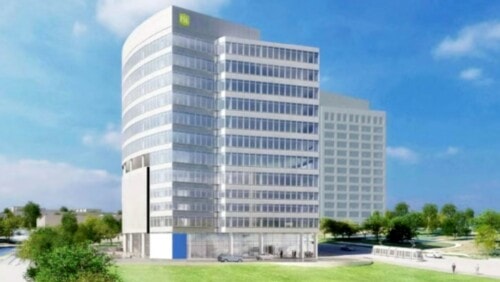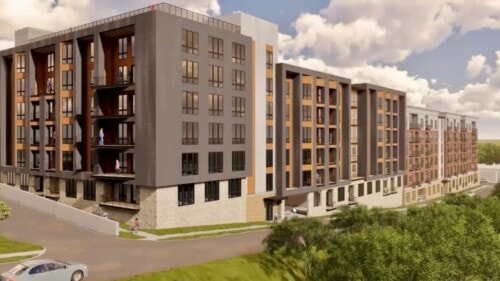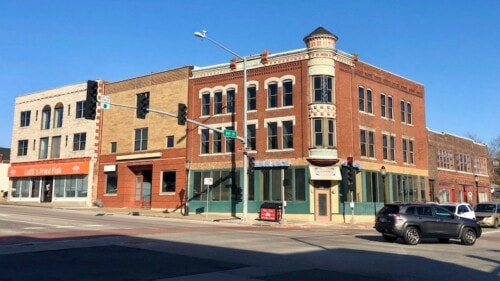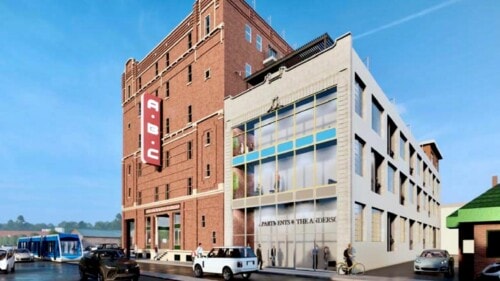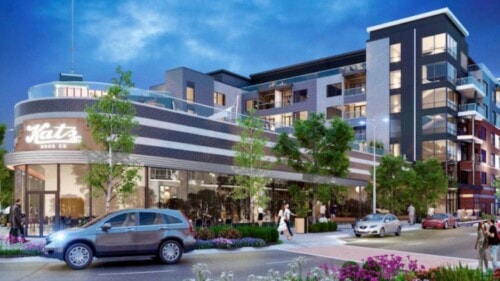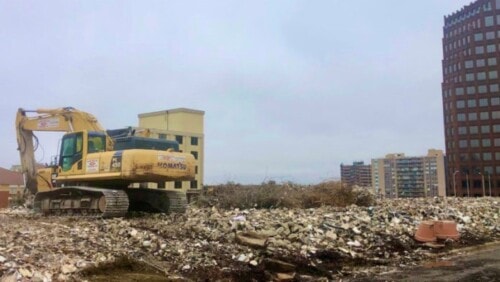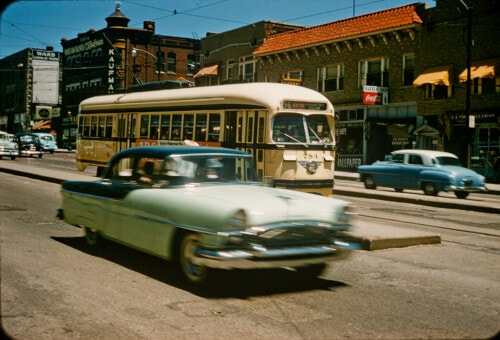KC Streetcar Extension Reshapes Midtown Real Estate Market Residents Ponder Increasing Home Prices, Property Taxes and Affordability for Renters
Published July 20th, 2022 at 6:00 AM
Above image credit: The new $350 million KC Streetcar extension along Main Street is expect to be completed in 2025. The project is attracting development proposals, including the redevelopment of the former Katz Drug Store at Westport Road and Main Street in the background. (Annie Jennemann | Flatland)The KC Streetcar extension along Main Street isn’t just about moving people – it’s about creating a new framework for development in Midtown.
“We have certainly noticed a major increase in interest in developing in the area, which is totally to be expected,” said Kevin Klinkenberg, executive director of Midtown KC Now. “That’s why we wanted the streetcar on Main Street to begin with, which was to reverse the decades of decline that we had.”
According to Klinkenberg, the census tracts in Midtown had a population of about 73,000 in the 1950s. Today, the population in those census tracts is closer to 28,000.
Midtown will soon be home to one of two streetcar extensions underway which will run from Union Station to 51st Street and Brookside Boulevard. The other extension will run from Third Street and Grand Boulevard to the Berkley Riverfront.
In Midtown, there are a variety of neighborhoods and markets for those looking to live close to the new route, which is expected to cost about $350 million, with half the funding coming from the federal government.
“There are very inexpensive places, there are very expensive places, there are very middle-of-the-road places,” Klinkenberg said. “And we’re really hopeful that over time we can retain as much of that as possible.”
Midtown Development
Midtown is one of the top three markets in terms of where people want to rent, said Caleb Buland, founder of the Exact Partners architecture and development firm.
“There’s a lot of great existing families that have homes there that are getting updated. So that’s really good for the city,” Buland said. “And then just to see all the new restaurants that have started to open up on the Main Street corridor.”
As interest in developing in Midtown has surged, particularly in new projects near planned streetcar stops along Main, ensuring affordable housing is a concern among some neighborhoods and people who live in the area.
“With more demand on that neighborhood, it becomes more expensive and harder to live there for people who are (on) low wages, or live on fixed income,” said Fourth District Councilman Eric Bunch.
Bunch emphasized a need to prioritize affordable units alongs the streetcar corridor.
“Because the people who depend on public transit the most are the ones who I think are (at) most risk of being, sort of, priced out of the neighborhoods immediately surrounding there,” Bunch said.
Scot Stockton, the president of the Old Hyde Park Neighborhood Association, one of the neighborhoods located along the Main Street extension, said one of the first questions they ask developers is about what they are doing for affordable housing.
“Whenever we find out developers are building, that’s one of the first questions is, ‘What are you doing for affordable housing?’” Stockton said.
Exact Partners tries to price its units 10% below its market competition and let others drive rent prices, Buland said. Also, buildings with more incentives actually allow them to lower rents even more.
Looking at the past five years, the first streetcar route from Union Station to River Market has prompted a huge concentration of development, according to Dan Moye, the director of land development at the Economic Development Corp.
Real Estate
If you’re looking to buy a house in Kansas City, the overall numbers reflect an affordable place to live.
Housing prices and rent are two separate issues along the streetcar extension. While concerns exist about rent and affordable housing on the extension, the overall housing prices are surging across the country.
As a whole, Kansas City is a relatively affordable market for housing compared to the rest of the country. In May, the median sale price of homes across the country reached $430,621, according to Redfin. This includes all residential properties.
In Kansas City, the median sale price was $278,000 — only 65% of the nation’s median price.
Both the national and Kansas City median sale prices of residential properties have shown a steady increase over the past decade, but Kansas City has consistently been lower than the national median.
The median home value of owner-occupied housing for Kansas City in 2020 was $163,300, according to American Community Survey 5-year estimates. This also trended below the rest of the country, which was $229,800. This includes the median value of already occupied housing, not sales.
The record high prices in Kansas City and across the country are probably separate from the streetcar, Bunch said, but that the problem possibly becomes even more of a challenge on the corridor.
In census tracts across the city, home values in census tracts between the State Line Road and Troost Avenue tended to have higher home values in 2020, according to American Community Survey 5-year estimates, but it still varies by neighborhood.
Even in the area surrounding the 3.5-mile streetcar extension, which includes neighborhoods like Southmoreland, Union Hill, Old Hyde Park and South Plaza, both median home prices and values vary based on the local market.
Southmoreland
The Southmoreland Neighborhood Association boundaries run from Main Street to Gillham/Rockhill/Oak streets and from 39th Street to 47th Street. Its southern border is diagonal from the Country Club Plaza, and its boundaries include the Nelson-Atkins Museum of Art.
In addition, the Southmoreland neighborhood will be home to the most streetcar stops on the new route with four stops located at 39th and Main streets, 43rd and Main streets, 45th and Main streets and Emanuel Cleaver II Boulevard and Main streets.
Southmoreland housing data reflects a fairly affordable area that is steadily increasing in recent decades. More recently, median sales have been documented above $300,000 in March of this year. The median sales price was reported at $302,350, according to Redfin.
The Southmoreland neighborhood includes two census tracts as of 2020 — all of 67 and about half of 66.
In 2010, the median home value of owner-occupied units in census tract 66, which runs from Main Street to Troost Avenue and Cleaver to 43rd Street, was $169,600 — the 49th highest of 173 census tracts in Kansas City limits.
Census tract 67, which is all located in Southmoreland, was the 84th highest at $132,500. It runs from Main Street to Troost Avenue and 43rd Street to 39th Street.
Like many other neighborhoods in Kansas City and across the United States, housing has become more expensive.
In the Southmoreland neighborhood, the change can be seen more in the past couple of years, Laura Burkhalter, president of the Southmoreland Neighborhood Association, said. Historically, there was housing for everyone, but it’s more of a challenge now.
In 2020, census tract 66 had a median home value of $173,200, only a 2.1% increase. In census tract 77, there was a 22.1% increase to a median home value of $161,800.
Home values may change, but Southmoreland is also home to many renters. Of occupied units in census tracts 66 and 67 in 2020, about 46% and 71.9% were renter-occupied units, respectively.
“We have large, very large homes, we have small homes, and then we have apartments and condominiums,” Burkhalter said. “So historically, we've had something for everyone in our neighborhood, no matter their budget.
“And now, we've seen that become more of a challenge, which is disappointing.”
The census tracts that include Southmoreland have seen some change in vacant housing, too.
“We do have a lot of vacant lots in our neighborhood that we are excited about the possibility of small scale infill for those,” Burkhalter said. “But people are cautious about home prices. We've seen a huge jump in home prices in our neighborhood.”
In 2010, more than 22% of housing units were estimated to be vacant in both census tracts 66 and 67, according to American Community Survey estimates. The percentage was down to 8.1% in 2018 but back up to nearly 16% in 2020.
However, residents in the Southmoreland neighborhood, like others, have concerns with short term rentals driving up prices.
“We have a lot of homes that are being sold to out-of-the-city owners who are operating them as short-term rentals, which is really, really heartbreaking when we're trying to have residents afford to live long term in our neighborhood,” Burkhalter said.
While the city requires short-term rentals to be registered, Burkhalter said there are about 50 unregistered short-term rentals in the Southmoreland neighborhood.
Burkhalter said with the shift from long-term to short-term rentals and the jump in rental prices, a lot of residents are no longer able to afford to live in the neighborhood.
“They're the people who would really rely on a free reliable streetcar when it comes or, you know, bus system to … being close to working school, or neighborhood as close to a lot of those,” Burkhalter said.
Union Hill
Some neighborhoods around the new streetcar extension, like Union Hill, were already more expensive than both Kansas City’s median sales price and median home value.
The boundaries of the Union Hill Neighborhood Association are Union Cemetery to 31st Street and Main Street to Gillham Road. Union Hill is small, geographically, and is located within census tract 44, which includes Crown Center and the National WWI Museum and Memorial.
In addition to being directly adjacent to the new streetcar route, this neighborhood is also already close to the current southernmost stop of the first streetcar route at Union Station.
In May, the Union Hill neighborhood had a median sales price of $390,000. A decade earlier, in February 2012, the median sale price was $200,000.
While the median sale price has mostly fluctuated over the past decade, it is trending slightly upward with the yearly low’s of the seasons getting higher over time. In 2021, the lowest median sale price for the year was recorded in May at $266,500.
Real estate in Union Hill may always be more expensive than other neighborhoods.
“With the small footprint of our community, the home values will always increase and slightly uptick above, you know, the average neighborhood,” said Stacy Garrett, a Realtor and president of the Union Hill Neighborhood Association. “Only because there are so few … single-family homes in our community.”
The neighborhood’s median home value for owner-occupied housing has also been consistently higher than the city’s, being the census tract with the 15th highest median home value in 2010 at $248,300, according to American Community Survey 5-year estimates.
Since 2010, the area has seen a 7.5% increase in median home value to $266,800 in 2020.
Even with higher home sales and values, the amount of vacancies in housing in census tract 44 has decreased from 2011 to 2020, going from 22.8% vacancies to 8.9% in 2020, according to American Community Survey estimates.
The census tract even saw a decrease of over 5 percentage points in vacancies in a single year from 2015 to 2016. The first streetcar route opened in 2016.
In census tract 44, the split between renters and owners of occupied housing units is fairly even, with renters making up 51.9% of residents in occupied housing units.
Overall, residents of Union Hill are excited about the streetcar and the improvement of walkability, Garrett said.
“We love it because it's walkable,” Garrett said. “But with that, the streetcar coming in, we're really excited about having more people in Kansas City stopping and seeing what's here in this part of midtown and making it more accessible.”
Other Neighborhoods
In the South Plaza neighborhood, ex-president of the South Plaza Neighborhood Association Keith Spare said there has been a constant stream of unsolicited calls and letters asking owners about selling their houses.
These calls and letters add another burden on residents to the “incredible” property tax payments, said Spare, who was president of the association for 26 years.
The South Plaza Neighborhood Association boundaries span across three census tracts: 73.01, 73.02 and 74. Prior to 2020, 73.01 and 73.02 were combined as census tract 73.
The median home value in census tract 73, which makes up the majority of the South Plaza neighborhood, was $323,400 in 2010. A decade later, in 2020, it was $423,300, according to ACS 5-year estimates, making it the second highest median home value in census tracts surrounding the streetcar extension.
In 2010, census tract 73 had a median home value of $313,400, but branched into two in 2020. Census tract 73.01 had a median home value of $347,300 in 2020, while census tract 73.02 had the highest median home value at $739,100.
The split did mean that census tract 73.02 was now not technically connected to Main Street, but it still overlaps with the South Plaza neighborhood association.
Additionally, the Broadway Gillham and Hanover Place neighborhoods, which are located within the Old Hyde Park Neighborhood Association on the streetcar extension, also had higher median home sales prices than the city’s in May 2022, according to Redfin.
Both neighborhoods have also seen sharp increases in median sales prices. In February 2012, the median sales price was reported in Broadway Gillham as $51,000. In May 2022, it was $321,875.
Similarly, the median sale price of homes in Hanover Place has increased from $164,500 to $370,000 in the same months.
Old Hyde Park is located within three census tracts: 51, 167 and 178. Even across the three census tracts, median home values differ.
In tract 51, the median went from $352,600 in 2010 to $360,800 in 2020 — dipping down to $269,000 in 2013 before going back up. Tract 167 has been less expensive than 51, going from $206,400 in 2010 to $241,500 in 2020, also experiencing dips in median value in the years between.
Tract 178 had the lowest median value in 2010 at $155,800, but surpassed tract 167 in 2020 with a median value of $264,500.
Future of Midtown
Midtown has transformed over decades, but there is still work to be done.
“I think if Kansas City's successful, it will be a vibrant walkable city, and transit will be woven into that so that you know you have some of your last mile transit that's very walkable,” Buland said.
Without the streetcar, Midtown is much like Waldo and Brookside — you need a car to go places, Moye said. However, with the streetcar extension, it will make Midtown much more approachable.
“I think that we saw with the first route that ridership drastically outpaced expectations, and I think that the hope is that that will happen through Midtown also,” Moye said.
“And so we'll see more and more ridership as there are more connections,” Moye said. “…It wouldn't surprise me to see some more jobs moving into that corridor because you've got easier access to folks that are jumping on that streetcar.”
Annie Jennemann is a Dow Jones data journalism reporting intern. She is a graduate student at the University of Missouri.



